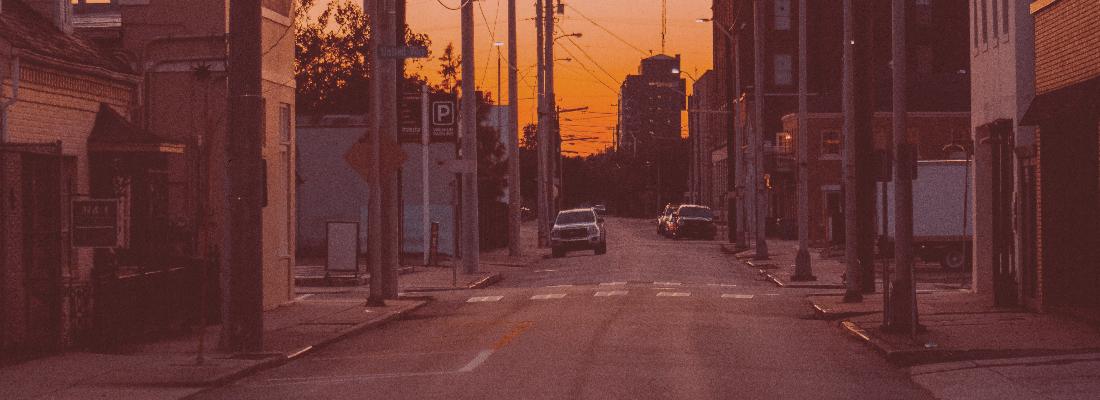JOHN RHOADES
Storytime
I noticed the beast first when the neighborhood kid went missing.
Camryn ran the irrigation ditch along the street, her styrofoam ship bobbing in the tiny rapids next to her, the ducks taking flight at her approach. This was every day after school. To the point where she was more background than flesh and blood.
Then the background shifted, and Camryn’s face looked down every day from the black and white flyers stapled to the wooden telephone poles. Down South Ave, back up North Ave. All across the Slant Streets. “Have you seen me?” Sure haven’t.
Camryn grew up from flyers to milk cartons. Milk cartons to billboards. Tearful pleas on the radio, “Our daughter is missing. Haven’t seen her in three weeks. Reward for any information.”
The pleas were everywhere, and then they were more background than paper and ink.

I noticed the monster next when my roommate’s cat went missing. I watched it disappear.
I was biking home at night. My wheels were a little slurry from the bars. The streetlights are motion-activated for the environment. Ahead of me, the street lit up. It took me a second to see the cat. I knew it was my roommate’s cat. The only flame point Siamese in town. The floodlights made her shadow more apparent than her body.
The lights are on ten second timers. One second: Her ears perk up, pointed away from me. Five seconds: Her back arches, tail rises to attention. Nine seconds: I can hear her hissing.
Ten seconds.
The light snaps off.
My roommate’s cat screamed. Her voice was cut. My bike coasted forward. The darkness was total. I couldn’t see anything. My movement triggered the sensor and the light snapped back on. The cat was gone. Only a slim trail of blood off into the dark.
There were more missing pets after that. Five dogs. Seven cats. A turtle. Banner sales week for Pets’R’Us.
The words rolled around the streets, questioning, accusatory, angry.
Solid money on it being a black bear, maybe even a grizzly. The minority had big bets on the quiet kid over on Kensington. Others on the spinster with the cats. A more unenlightened time might drag a hag to the main square, tie her up, and burn her on a wood pallet barbecue.
We are better than that. Just don’t read the Facebook comment section.
Henry Jenard, over on Arthur Ave, he likes to hold neighborly conferences across the top of his fence. “Well,” Henry starts off his suburban sermon, “the mayor doesn’t know what’s coming. I’d put my money on something we’ve never seen before. At least not here. I have a cousin who lives down in Idaho. Same thing started to happen. Kids, pets, and the homeless gone if they were caught out alone after dark. My cousin said it was some kind of monster. The only way to appease it was a timely sacrifice. They leave a goat outside of town every other week. That seemed to do it.”
The city releases a notice: keep your kids and pets locked up after dark. Don’t go out alone. Carry a gun if you got it.

Three weeks later our questions were answered.
Mr. Rodgers was walking with his wife Donoris around sunset down by Franklin Park. A pretty spot, populated, busy. With the sun only starting to sink, they figured they’d be safe.
The grass-cracked basketball court was empty despite the long light of mid-summer. Mr. Rodgers and Donoris moved through the lambent summer golden hour. “Warm for this time of year.”
Donoris just nodded. “Sure is, sure is.”
They shuffled around the park, doing their doctor-dictated daily rounds. As they came back past the playground a shadow, longer than the others, separated from the swing set. Donoris pointed at the painted mural the preschool kids had drawn. Mr. Rodgers choked.
Donoris turned to see if Mr. Rodgers was alright. Sure wasn’t. Donoris found her spouse splayed out upon the ground. His head and half his chest swallowed by a pulsing and shadowy mass. By the time she screamed, the apparition finished with Mr. Rodgers and moved to swallow her.
The playground parents screamed, terror reigned, and our housing monster had arrived.
Biologist News Pundit
The housing monster is a well-known species actually. The main species is Urbanus rentierus. Subspecies have been documented in San Francisco: Urbanus tenderloin, in Montreal: Urbanus parkdale, in New Orleans: Urbanus katrinus. However, the generic Urbanus rentierus appears across the country. A quiet hunter, it arrives unannounced and by the time most ecosystems are aware of its presence, it’s already too late. It starts by picking off the easy marks; the aged, the disabled, drug users, and felons. By the time these prey grow too scarce, it grows bolder. Taking on students, minorities, and single mothers. This is when most of the warning flares go up. Again, it is too late. The beast is now established in the urban ecosystem, and I’ve never seen one leave. Invariably there are those in the community that are feeding the beast and have been for a while. The beast grows, it washes over the town until it becomes common to watch it absorb people on the street. Opaque tendrils wrap over the victims and pull them into the larger body. My advice? You should probably move.
MAN ON THE GROUND JIM
For those just joining us, we are following the rampage of a creature terrorizing the streets below our helicopter. You can see it moving up Orange St. It started at Franklin Park and is slowly making its way north. We saw it swallow three people already. Oh! Oh no. Make that four people.
Folks, please stay home. Do not go outside. We haven’t heard from the Governor or any authorities yet, but we will let you know when we do.

Did You Know
Did you know? There are 100,000 people missing from New Orleans. Did you know that all those missing people are Black? Some said Katrina carried them away. Perhaps it did blow them outside of town. But what happened when they tried to return? They must have seen the repaired houses, each one whitewashed. They must have wandered the towns like ghosts, wondering at all these pale-faced strangers in the streets they once called home. Or maybe they never tried to come home. After all, the government only gave aid money to the people that stayed away. Did you know that housing is a racial issue? Of course you did.
Journal Entry: Day 2
The monster has established itself outside the old Mercantile building. The mayor came to speak with it. The creature only pointed at its mouth expectantly. The mayor shrugged, grabbed the nearest intern, and threw them forward. The monster ate the proffered food, smiled, and bedded down to sleep.
Later that day, City Council released a list of citizen names. At the top were convicts, felons, sexual predators, and drunks. Then came the homeless. After that were the disabled. Anyone in a trailer home next. Any racial minority. People on social security. The generally aged. College dropouts. College students. The lower middle class. The list ended there. After that, it got a little too close to home.
Whenever the monster raises its head, the name at the top of the list must be there and waiting to “cater to the needs of our most exultant guest,” the city ordinance reads.
My name is fairly low on the list. Thank god.
Paranormal Normies: with host R. L. Gheist
On this episode of Paranormal Normies, we go into the heart of a sleepy Montana town to investigate widespread reports of ghosts wandering the streets in full daylight.
Some say the ghosts have something to do with the appearance of a giant housing monster in the center of town and are the ghosts of its victims. The appearance of so many ghosts in one spot is almost unheard of. The only reports we have of such a phenomenon come from ancient texts associated with the second coming. Is this the first stage of the apocalypse? Are we all doomed? Stay tuned to find out.
The Nightly News
The newsmen pulled up outside Mr. Rodgers and Donoris’ house. “What happened?” Their ghosts only flickered in the spotlight.

Journal Entry: Day 60
The housing monster grows larger by the day. The steady sacrifice of our least desirable citizens is not enough to appease the beast. We must feed it collectively. We must pay a tithe, a tax, a rent to the monster. We discovered that it likes gold, pearls, and cold cash. We also found that when cash fails flesh works.
The old list of sacrificial undesirables has been scrapped and a new ordinance has gone out. If you don’t pay the tax then the entirety of your person will be proffered to our esteemed guest.
I suppose I should have bought less avocado toast.
Sacrifice or Sacri-nice?
So you’ve got a housing monster, bummer! We went on Reddit and asked folks for their stories on the best way to keep the monster happy… and not eating them.
1. Make your payment promptly. u/GlutenTamerShirley said: I break into abandoned houses on the first of every month to find enough spare gold and diamond jewelry to dump into the monster’s mouth. I had some friends who waited a few days. Let’s just say I don’t have as many friends anymore lol.
2. Flesh works! u/TongueDepressorGagreflex wrote: Look sometimes you can’t find the money. There is no shame in that. And you know what? The monster is understanding. It is totally cool to walk up to that bad boy and just throw him your thumb. That’ll get you a month of easy living. Give it a whole leg? You’re set for a year!
3. Use friends/family. u/MyOtherCarIsaVulva added: We can’t all pay every month. The cost is just too steep. But that doesn’t mean you should just expect to get eaten. Like that’s such a bummer. I just throw my family in instead. I had this Aunt Shirley who was always asking when I was going to settle down and have a kid. I took her downtown for brunch, and on the way I pushed her into the monster’s mouth. Easy. No more Shirley. Did the same for my Uncle Verl, my little brother, and my moochy friend Miles. #savemoney #getpeace #itsakindnessreally

Did You Know?
Did you know? There are five stages to gentrification. They say the first is when the queers arrive. As if it’s their fault. As if they weren’t canaries burning in the coal mine.
Notes From the Field: A Monster Breeder
There are a few tools you’ve got in your pocket when preparing to raise a housing monster. It used to be you could use a bit of redlining, a little race-based zoning, and call it a day. Things aren’t so simple anymore. You have to take the long game. You have to build the ecosystem from the ground up.
Start with a place that’s just past being hip. Sell it to the corporate professionals who think ‘strong community’ is a checklist item like ‘has a yard,’ or ‘natural light.’
Now get a fairly well-off population that can buy up absolutely everything in the market. Make that vacancy rate zilch.
Some uppity folks are going to say you need more housing units. Don’t listen to them. Say you’re worried about preserving the natural and historical character of the neighborhood.
Now, all the units are wrapped up, and no one can build new ones. You’re going to sell the hell out of the town. Sell why it’s great. Sell why you love it. Sell why Oprah loves it and why only the smartest folks are retiring there. Your habitat is ready and your housing monster should arrive on its own. Matter of fact, it’s knocking on your door right now.
A housing haiku from the Poetry Corner:
I count my good friends
Every day, more are missing,
Marco… Marco…Mar—
Thick Description
An ethnologist came to town. She had a grand plan to write a book about the housing crisis and do a think piece on the housing monster. At the bar, you’d hear her ask, “But who is the monster, really?”
We’d watch her walking around town in her pith hat and cargo vest, loaded down with notebooks and audio recorders. She’d stop and talk with anyone. The ghosts, the locals, the monster.
Apparently, she was looking for an ideal candidate to follow and write about. She started following me, and I didn’t know how to shake her.
“Do you want to see the first of the month’s sacrifice?” I asked her. That’s what the TV people like. “I’m just here to watch and listen,” she said, “live your life normally, that’s enough.”
I took her on a looting run. We went up into the South Hills and ripped open the mansions like Christmas presents. “What about the people that live here?” She asked. No one lives here now, they only come in the Summer.
In one of the houses we found a cluster of ghosts lingering in a bedroom, their silent faces wondering, Can we stay?
Routine
There’s a live cam of the monster. People watch it while they work. They say things like, “My how big it’s grown, I remember when it was just a little guy.”
People place bets on how many folks it can eat in one day. How much it can stomach. The largest bet tends to win.
Artists stand on the rooftop around the beast and try to depict its likeness. Perhaps the most disturbing, compelling aspect of the monster is that all of its victims are clearly visible inside of it. They look like action figures stuck inside a roiling pile of jet-black bubble gum. The bodies are animated, their eyes white, their teeth always gnashing, sometimes screaming. Invariably, the artists get too close to the beast to get the best angle. Dying for your art has to be a good way to go, right?
Zoning
Jane Jacobs says, “We expect too much of new buildings, and too little of ourselves.” I stood in City Hall and shouted that phrase. I ran over a bridge at midnight spray painting that phrase across concrete and girders. I tattooed it across my forehead, cut my head from my shoulders, and mailed it to the mayor.
New buildings grow like dandelions along the sidewalks around town. New buildings grow everywhere, and yet our town feels emptier, quieter.

Did you know?
Did you know I forgot to tell you about the last stage of gentrification? The last stage is when the houses are more valuable empty than filled. The last stage is when the boot-strappers come, their stomachs surgically replaced with bank accounts and stock portfolios. The last stage is when the market has eaten everyone in town and all the apartments stand empty, their doors open, wondering where all the food went.
That’s what the housing monster/crisis/problem is: a capital washing machine that cycles out all the flesh and blood.
Journal Entry: In the Belly
Would it hurt you to know that I fed the beast? I snuck out in the evening with my piggy bank. I stood over the waiting mouth and emptied pennies and silver dollars into its gullet.
It’s like Mr. Jenard said: Just give it a sacrifice and it won’t come for you. Leave your goat as a sacrifice, and sleep through the screams.
I wish things were so simple as right and wrong. I have worn masks and carried the elderly to the center of town atop couches like palanquins, yelling as they were eaten. Sometimes I dream of being a landlord (passive income baby!) and why not? I wouldn’t be that bad. After all, this whole process is codified in law, landlords are always within their rights. When I think those thoughts I wake up inside the monster’s body, howling, screaming, biting at all the bodies that come too near.
Someone said that you should pay rent like you’re making a sacrifice. Pay your rent like you’re painting a mark upon your door in sheep’s blood saying to the beast, “I am protected, find my neighbor.” Pay your rent with intention. Pay your rent in blood. Pay your rent like something vital is being stolen from you, and don’t forget that something is.
Pay your rent like it’s me or you, because it is.
And when I feed you to the beast I’ll wonder, “Was there any other way?”




